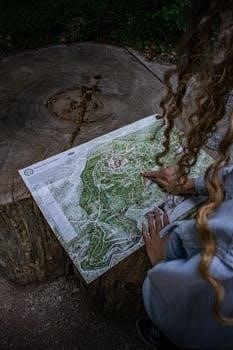Overview of the Pathfinder 2e Gamemastery Guide
The Pathfinder 2e Gamemastery Guide is a 256-page rulebook designed to aid Game Masters in crafting engaging and dynamic campaigns. It offers a plethora of tools and rules for adventure building, world creation, and NPC design, enhancing the storytelling experience for all. It provides advice for both new and experienced GMs.

Purpose of the Guide
The primary purpose of the Pathfinder 2e Gamemastery Guide is to empower Game Masters (GMs) with the resources and knowledge needed to create memorable and engaging Pathfinder Second Edition campaigns. It serves as a comprehensive toolkit, providing guidance and rules for building adventures, designing compelling NPCs, and crafting immersive worlds. The guide aims to enhance the GM’s ability to tell captivating stories and facilitate dynamic gameplay. It offers practical advice for both new and seasoned GMs, ensuring that every game session is unique and enjoyable. It also assists in managing game mechanics, allowing GMs to focus more on storytelling and player interaction. The guide encourages creativity and improvisation, allowing GMs to adapt and customize their campaigns to suit their playstyles. It also introduces new game systems like chases, tournaments, and duels to add variety and excitement to the game. It aims to be a central resource for GMs, promoting a more versatile and exciting Pathfinder 2e experience. It’s designed to be a go-to guide for all aspects of game mastering.

Content and Features
The Gamemastery Guide includes adventure building advice, world and settlement design tools, and NPC creation methods. It also provides rules for chases, tournaments, and duels, along with a gallery of sample non-player characters. This book offers a wide variety of resources.

Adventure Building Advice
The Gamemastery Guide offers comprehensive advice for crafting compelling adventures, catering to both novice and experienced Game Masters. It delves into techniques for structuring engaging narratives, providing guidance on pacing, plot hooks, and creating memorable encounters. The book emphasizes the importance of player agency, encouraging GMs to adapt their plans based on player choices and actions. It includes methods for designing balanced challenges, ensuring that adventures are both exciting and fair. Furthermore, it provides tips on using environmental storytelling to enhance immersion and create a more atmospheric experience. The guide also covers the creation of diverse locations and scenarios, providing tools to make each adventure feel unique and tailored to the players. It also emphasizes the use of foreshadowing and thematic elements, making sure the players are always engaged. The Gamemastery guide is a valuable asset for building rich adventures.
World and Settlement Design
The Pathfinder 2e Gamemastery Guide provides detailed guidance on crafting immersive and believable worlds and settlements. It explores various aspects of worldbuilding, including geography, cultures, and history, encouraging GMs to create rich and diverse settings. The guide offers methods for designing settlements of all sizes, from small villages to sprawling metropolises. It emphasizes the importance of considering the social, economic, and political factors that shape each location, giving them unique identities. It also provides advice on creating memorable landmarks and points of interest, enriching the player experience. The Gamemastery Guide includes tools for generating random encounters and events, making each visit to a settlement feel unpredictable; This section helps GMs design living, breathing worlds that are more than just backdrops, becoming integral parts of the story. The book stresses the importance of detail and consistency in establishing the world’s lore, making the setting feel real.
NPC Creation and Usage
The Pathfinder 2e Gamemastery Guide offers comprehensive strategies for creating compelling and memorable Non-Player Characters (NPCs). It goes beyond simple stat blocks, delving into methods for crafting detailed backgrounds, motivations, and personalities. The guide encourages GMs to think about how each NPC fits into the overall narrative, and how they can drive the plot forward. It provides practical advice on roleplaying NPCs, giving them unique mannerisms and voices to bring them to life. There are tips for creating both allies and adversaries, with guidelines on making their interactions with the players feel meaningful. The book also includes a variety of sample NPCs that GMs can use as inspiration or drop directly into their campaigns. This section aids in designing characters that are more than just quest-givers or combat encounters, becoming integral parts of the story. It also covers how to use NPCs to provide information, drive conflict, and create emotional investment. The Gamemastery Guide helps GMs make NPCs feel like real people with their own agendas and stories.
Rules for Chases, Tournaments, and Duels
The Pathfinder 2e Gamemastery Guide provides structured rules for handling dynamic encounters such as chases, tournaments, and duels. These rules offer a framework for GMs to create exciting and engaging scenes beyond standard combat. The chase rules detail how to manage movement, obstacles, and the tension of pursuit, adding a thrilling element to scenarios. Tournament rules provide a way to run structured competitions, complete with unique challenges and rewards, enhancing the roleplaying experience for players seeking glory. Duels are handled with specific rules to ensure a dramatic and balanced one-on-one conflict, focusing on skill and strategy. These systems are designed to make these encounters feel cinematic and impactful, incorporating various skills and abilities. The guide includes guidelines for creating different types of challenges for each system, ensuring flexibility and replayability. These rules are not just about mechanics; they are tools for storytelling, allowing GMs to craft memorable scenes that resonate with players. The guide encourages GMs to adapt these rules to their own style, fostering creativity.

Specific Sections
This section delves into the core components of the Gamemastery Guide. It covers essential topics such as gamemastery basics, tools for GMs, various subsystems, and variant rules. Additionally, it includes a detailed NPC gallery for immediate use in campaigns.
Gamemastery Basics
This section introduces the fundamental concepts of being a Game Master in Pathfinder 2e. It emphasizes that the GM is responsible for the narrative and the world that players explore. The guide provides an overview of running the game, offering advice and guidance for new and experienced GMs alike. It covers the importance of storytelling, creating engaging scenarios, and managing the game’s flow effectively. The section also touches upon the GM’s role in presenting challenges, roleplaying non-player characters, and adapting to player actions. Gamemastery basics sets the foundation for using the tools and systems detailed throughout the rest of the book. Additionally, it establishes the core principles of creating a fun, fair, and memorable experience for everyone at the table. This section also discusses how to manage player expectations, encourage collaboration, and maintain a positive gaming environment. It’s the starting point for anyone wanting to become a proficient GM.
Tools for Game Masters
This section of the Gamemastery Guide provides a variety of practical resources for GMs. These tools are designed to streamline game preparation and enhance in-game flexibility. The guide includes advice on building creatures, designing encounters, and creating unique treasures. It offers systems for generating random elements, such as loot and environmental hazards, aiding in spontaneous game creation. Furthermore, it provides methods for tracking initiative, managing combat, and handling complex rule interactions. The tools also focus on fostering creativity, enabling GMs to customize their campaigns with bespoke content and challenges. This section also contains useful tables, charts, and templates that can be readily implemented at the table. These tools are designed to be time-saving, allowing GMs to concentrate on storytelling and player engagement rather than complex mechanics; The section includes also guidance on adapting existing adventures and creating homebrew content.
Subsystems
The ‘Subsystems’ section of the Gamemastery Guide introduces a range of optional rules and mechanics that GMs can incorporate to add depth and variety to their games. These subsystems cover a wide array of situations, from complex chases and thrilling tournaments to dramatic duels. Each subsystem is detailed with clear instructions and examples, allowing for easy implementation. These rules enhance the game experience by providing a framework for resolving intricate situations beyond standard combat. Furthermore, the subsystems include guidelines for crafting custom challenges, adapting existing ones, and integrating them seamlessly into ongoing narratives. The section also explores various interaction methods between subsystems to offer complexity and variability. The book provides frameworks that can be used for social interactions, exploration, and investigation. These allow for a more narrative and cinematic gaming experience. This section aims to offer new ways to play the game by adding new mechanics and systems.
Variant Rules
The “Variant Rules” section of the Gamemastery Guide provides a collection of alternative rules that GMs can use to customize their Pathfinder 2e campaigns. These optional rules offer different approaches to core game mechanics, allowing for a more personalized gaming experience. Variant rules can alter combat, exploration, character advancement, and skill usage. This allows the GM to tailor the game to their preferences and player expectations. The section also includes guidelines on how to implement these rules and how they might affect the overall balance of the game. There is advice on how to mix and match these rules to create a unique playing style. Additionally, this section encourages GMs to experiment and create their own variant rules. The rules are presented as options, allowing groups to find the best fit for their play style. The goal is to enhance the flexibility and adaptability of Pathfinder 2e.
NPC Gallery
The “NPC Gallery” section in the Pathfinder 2e Gamemastery Guide provides a diverse collection of pre-generated non-player characters that GMs can easily integrate into their campaigns. This gallery includes a variety of NPCs, from simple town guards and merchants to more complex villains and allies. Each NPC comes with detailed stat blocks, background information, and roleplaying notes, making them ready for immediate use. The gallery aims to save GMs time and effort, offering a convenient resource for populating their game world with interesting and unique characters. The NPCs are designed to fit a wide range of settings and scenarios, making them versatile additions to any campaign. This section aims to inspire GMs by showcasing how to create memorable and impactful NPCs. It encourages GMs to adapt and modify the provided characters to fit their own creative visions. The gallery serves as a valuable resource for both experienced GMs and newcomers looking for quick and easy NPC options.